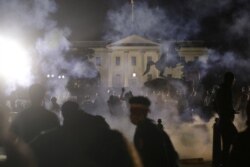On Monday, the president of the United States suggested he would use federal troops to end unrest across the country.
The unrest started over a week ago after the killing of George Floyd, a black man. He died a short time after he was detained by police in Minneapolis, Minnesota.
People in Minneapolis and other U.S. cities have been protesting Floyd’s death. Some of the protests were peaceful, but others were not. Demonstrators attacked businesses, set fire to buildings, and burned cars.
Speaking from the White House, President Donald Trump proposed using military troops to stop the violence. He said, “If a city or state refuses to take the actions that are necessary to defend the life and property of their residents, then I will deploy the United States military and quickly solve the problem for them.”
Several state governors quickly rejected Trump’s proposal. The governor of Oregon, Kate Brown, said, “You don’t defuse violence by putting soldiers on the streets.” In Illinois, Governor J.B. Pritzker said he does not believe the federal government can send troops into his state. And New York’s governor, Andrew Cuomo, added, “I say thank you but no thank you.”
All three governors are members of the Democratic Party. Trump belongs to the Republican Party.
To deploy military troops, the president would need to invoke legislation known as the Insurrection Act.
What is the Insurrection Act?
Under the U.S. Constitution, governors generally have the power to maintain order within state borders. The constitution bars the armed forces from law enforcement within the country.
The Insurrection Act of 1807, however, gives the president power to send troops to the states “in all cases of insurrection, or obstruction to the laws.” The law has since been amended several times.
In a 2006 report, the U.S. Congressional Research Service said the president is required to have approval from a state’s governor or legislature to send in federal troops. But the report also noted that “the President may issue an executive order to send in troops.”
Presidents have invoked the Insurrection Act several times in U.S. history.
In 1957, President Dwight Eisenhower approved an executive order to put the Arkansas National Guard under the U.S. military. As part of the order, he sent 1,000 Army troops to Little Rock, Arkansas. The move, over the objection of the state’s governor, was to protect black students at an all-white high school.
The Congressional Research Service said the use of the Insurrection Act “has become exceedingly rare” since the end of civil rights protests in the 1960s.
The act was last used in 1992. That was the year when racial protests in Los Angeles turned violent. The unrest started when a court found four police officers – all of them white -- not guilty in the beating of a black man, Rodney King.
Thaddeus Hoffmeister is a law professor at the University of Dayton. He told the Reuters news agency that when the Insurrection Act was invoked in the past, presidents and governors have usually agreed on the need for troops.
In 2005, then President George W. Bush decided not to use the act to send troops to Louisiana after flooding resulting from Hurricane Katrina. The state’s then-governor opposed the move.
Hoffmeister said he did not think invoking the Insurrection Act was needed now because governors can take action through their criminal justice systems.
I'm John Russell.
Hai Do wrote this story for Learning English with information from the Congressional Research Service and Reuters. George Grow was the editor.
________________________________________________________________
Words in This Story
resident - n. someone who live in a particular place
defuse - v. to make something less tense or serious
invoke - v. to make use of a law
maintain - v. to continue doing something
issue - v. to announce something in an official way









